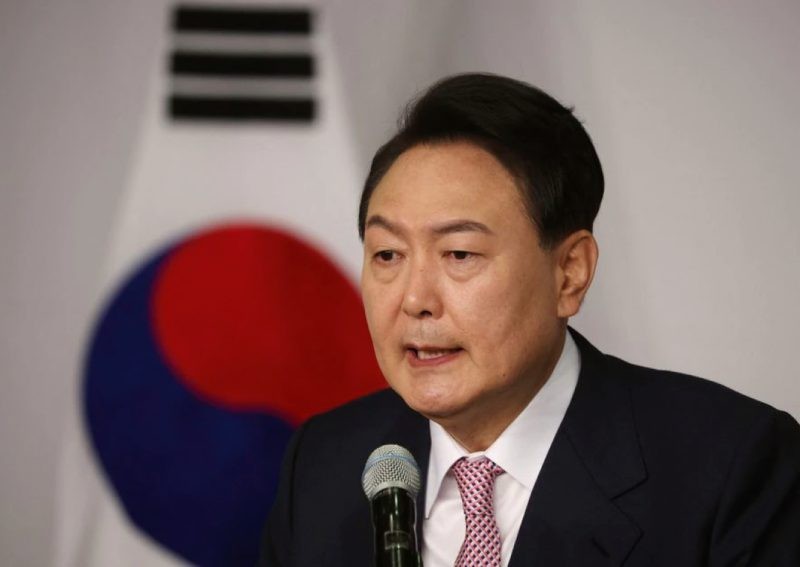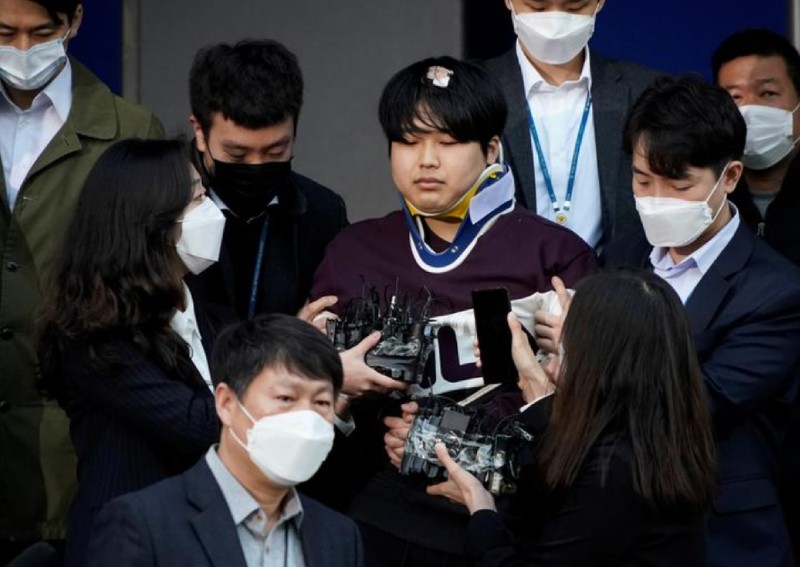Caught on camera: The moment when students ran out of classrooms after an earthquake
It’s possible that I shall make an ass of myself. But in that case one can always get out of it with a little dialectic. I have, of course, so worded my proposition as to be right either way (K.Marx, Letter to F.Engels on the Indian Mutiny)
Sunday, May 22, 2022
NZ
Smeagol The ‘Gravel Maggot’ Leaves Its Rare Mark On The Remote West Coast
Press Release: Department of Conservation
An extremely rare species of sea slug or ‘gravel maggot’ has been detected for the first time on a remote beach in South Westland.

In late January, a team of three scientists from the University of Canterbury (UoC) Marine Ecology Research Group and two Māhaki ki Taiao rangers travelled to Hautai Marine Reserve, 85km south of Haast. Hautai holds the title of New Zealand’s most remote mainland marine reserve.
The trip was a great success, despite COVID and some wild weather complicating trip planning.
“We saw a large storm system approaching and managed to squeeze this work into a tight weather window, and get helicoptered out shortly before it hit,” says UoC researcher Shawn Gerrity.
This trip is part of the Department of Conservation’s marine monitoring work. It was repeating monitoring work last done in 2017 to see if any changes have occurred.
Aside from repeating the previous monitoring this team also employed a new and growing technology for detecting the presence of species: eDNA.
eDNA works by passing a litre of seawater through a very fine filter. DNA fragments are left in the water by plants and animals that have been in the area recently. These fragments collected in the filter are sent to Wilderlab in Wellington to be analysed. About 500 different species were detected from the eDNA samples from Hautai Marine Reserve, ranging from bacteria to dolphins.
“We were incredibly shocked and delighted that the results came back confirming the presence of Smeagol within the sample that was taken” says Don Neale, Marine Ranger for the West Coast.
The gravel maggot’s scientific name, Smeagol, comes from the mysterious pale-skinned character in The Lord of the Rings. “The gravel maggot has a similar lifestyle, living up to 30cm down under the gravel beach surface. That makes it very hard to find and study, but the eDNA method is one way to do that.”
“It has previously only been found in two places – a small beach on the south coast of Wellington, which was thought to be its only home, until it was discovered that a genetically-distinct population also exists in Kaikōura.
It’s not yet known whether this new population at Hautai Marine Reserve is its own species or related to one of the two known populations, which are 750km and 950km away, respectively.”
“To figure this out would be a pretty major undertaking,” says Don. “We would need to go back in to Hautai and spend some time digging carefully around gravel or under boulders to see if we can find any live gravel maggots there.”
This may not be likely any time soon, considering access to the study area requires a helicopter or a two-day walk from the nearest road end. But Don hopes there will be an opportunity to do some searching the next time monitoring is done around the Hautai Marine Reserve.
Little is known about the Smeagol sea slug or its ecological role. “Although they’re very small and inconspicuous, coastal animals like Smeagol likely have some role to play in recycling nutrients from beachcast kelp back into the thriving ecosystems of the surrounding oceans.”
“Their name, ecology, and threat status all give Smeagol a bit of an iconic status” says researcher Don. “And it goes to show how much more there is to learn about our marine environments, with dozens of new species discovered in New Zealand every year.”
Bachelet Calls On Mexico To Step Up Efforts As Tragic Milestone Reached Of More Than 100,000 Disappearances
Press Release: UN High Commissioner for Human Rights
GENEVA (17 May 2022) – UN High Commissioner for Human Rights Michelle Bachelet on Tuesday called on the Mexican authorities to step up efforts to ensure truth and justice for victims of disappearances, who now number more than 100,000, according to official data.
“The scourge of disappearances is a human tragedy of enormous proportions,” said Bachelet. “No effort should be spared to put an end to these human rights violations and abuses of extraordinary breadth, and to vindicate victims’ rights to truth, justice, reparation and guarantees of non-repetition.”
A national registry has been compiling disappearances dating as far back as 1964. According to the database, about a quarter of those documented to have disappeared are women, while around a fifth were under 18 at the time of their disappearance. More than 97 per cent of the disappearances whose date is known occurred after December 2006, when Mexico transitioned to a militarized model of public security.
Only 35 of the disappearances recorded have led to the conviction of the perpetrators. This staggering rate of impunity is mostly attributable to the lack of effective investigations. It leaves victims’ families, already deeply affected by the disappearance of their loved ones, to cope alone with the additional burden of trying to ascertain what happened to them.
“During my visit to Mexico in 2019, I was able to see first-hand the courage of the victims’ families, who were key actors in organizing and proposing solutions, and achieving legal and institutional progress towards recognizing the magnitude of this issue in Mexico,” the High Commissioner said.
Bachelet paid tribute to all the family members who have persevered over decades in pursuit of the truth and justice, including Rosario Ibarra de Piedra, whose son Jesús Piedra Ibarra was forcibly disappeared in 1975. Doña Rosario, who died in April, helped to locate some 150 disappeared people alive and return them to their families.
Mexico has taken significant steps, including the adoption of the General Law on Disappearances and the creation of search committees in all states. It has also set up committees to examine serious human rights violations that occurred between 1965 and 1990, as well as the 2014 enforced disappearance of 43 students from Ayotzinapa, and established the Extraordinary Mechanism for Forensic Identification.
Mexico in 2020 recognized the competence of the UN Committee on Enforced Disappearances (CED) to examine individual complaints. In June 2021, in a historic decision, the Supreme Court recognized the binding nature of the CED’s Urgent Actions. In November 2021, Mexico became the first country to accept a visit by the Committee, which went to 13 Mexican states and held more than 150 meetings with authorities, victims’ organizations and NGOs.
Bachelet said she hopes these positive steps will pave the way to prevent further disappearances, clarify the whereabouts of those who have disappeared, improve access to justice and guarantee the rights of the victims.
The High Commissioner called on the authorities to place the families of those who have disappeared at the centre of their efforts, and to make the necessary resources available for investigations and searches to be effective.
Bachelet also called on Mexico to effectively implement all the recommendations of the Committee on Enforced Disappearances, as well as all the provisions of the General Law on disappearances, including by creating the National Forensic Data Bank and the National Programme of Exhumations and Forensic Identification.
NZ
Support workers rallying for urgent pay increase
Press Release – E tū/NZNO/PSA
Care and support workers, their employers, and the clients and residents they care for are rallying together for the first time to secure an urgent pay increase for workers in the sector before legislation that sets their pay and qualifications requirements expires in just over a month’s time.
Around 65,000 care and support workers fear an uncertain future if the Government doesn’t agree to boost funding to provide a substantial increase in their pay rates.
However, the Government has so far indicated there’s unlikely to be funding for more than 70 cents an hour per worker for an 18-month period.
Future fair pay is also far from guaranteed with the parties yet to determine how pay rates will be set beyond the current legislation expiry.
With inflation running at 6.9 percent, care and support workers, who perform essential services for elderly, disabled, or those with mental health and addiction needs, are struggling to survive.
Care and support workers and their allies are holding rallies and events across Aotearoa to push for a pay rise and highlight their concerns today.
Historic Pay Equity Settlement
Tuesday, 17 May 2022, 2:44 pmPress Release: All District Health Boards
An historic agreement has been ratified that addresses a long-standing undervaluation of a workforce that is critical to the smooth running of our hospitals and the delivery of healthcare.
DHB spokesperson Jim Green says the pay equity settlement covers more than 10,000 people in the Health Administration workforce across District Health Boards.
“Over 90 percent of the people in these key administration and clerical roles are women, and their work has been historically undervalued – this settlement puts it right.
“It’s been an enormous undertaking to get to this point and it is important to acknowledge the tireless work of the PSA and the DHBs’ team over the 4 years this work has taken.”
Mr Green says the new pay system agreed with the PSA provides a standard structure for more than 1500 roles across 20 DHBs with previously widely variable rates.
The following are examples of individual increases on annual full time pay rates for people who translate to the new top-step rate – including a $2,500 adjustment paid since late 2020:
- Ward Clerk, South Island: $48,740 to $68,340 – an increase of 40%
- Clinical Coder, Auckland: $51,753 to $69,340 – an increase of 34%
- Health Records Clerk North Island: $50,840 to $57,630 – an increase of 13%
The increases for individuals vary greatly, with people on lower starting points seeing substantial increases while those who were being paid closer to the final agreed rates receiving smaller increases.
Each person covered will also receive a $2500 pro-rated lump sum recognising the delay since the interim pay adjustment of 30 November 2020.
“The settlement provides something this group has never had before – consistent national pay rates as part of a job banding structure.
“Just as importantly, it also provides a process to maintain pay equity in the future.
“The union has worked in partnership with the DHBs to reach this outcome, which will have a substantial impact on lifting the pay of a low paid, female-dominated workforce.
“It has been a long time in the making and I want to congratulate those who’ve worked long and hard to get us to this point. It would not have been possible without the commitment and goodwill of all those involved, including the Government’s support for addressing this issue.
“The Health Administration workforce makes a critical contribution to health services for New Zealanders – this pay equity settlement recognises that and will make a significant difference to them, their whānau and the wider community.”
Mr Green says this is the first of four pay equity settlements in the health sector with agreements expected in Nursing, Midwifery and Allied Health within the next 12 months.
20 May, 2022
/cloudfront-ap-southeast-2.images.arcpublishing.com/nzme/WJSZTPHJ5VHTME3TLBBWRUJV6Y.jpg)
Facebook owner Meta has told staff not to talk about abortion on internal communication boards over fears of becoming a "hostile work environment".
Daily Telegraph UK
By Gareth Corfield
Facebook owner Meta has told staff they are banned from talking about abortion on the company's internal discussion boards over fears of becoming a "hostile work environment".
Employees of Meta, which also owns Instagram, are not permitted to post about abortion on the company's Workplace tool, a Facebook-style website intended for internal communications.
Janele Gale, human resources vice-president, told staff that abortion was "the most divisive and reported topic" on Workplace, according to tech website The Verge.
Gale reportedly said "even if people are respectful, and they're attempting to be respectful about their view on abortion, it can still leave people feeling like they're being targeted based on their gender or religion".
The site reported other internal Facebook directives from early May suggesting abortion could only be discussed in groups of no more than five people.
Abortion has regained political prominence in the United States after leaks earlier this month suggested the Supreme Court is poised to overturn a legal precedent preventing states from banning abortion. A decision is due at the end of June or the beginning of July. The landmark 1973 ruling Roe v Wade legalised abortion in the US.
Meta has been asked for comment.
Keep up to date with the day's biggest storiesSign up to our daily curated newsletter for the day's top stories straight to your inbox.
SIGN UP
By signing up for this newsletter, you agree to NZME’s Terms of Use and Privacy Policy.
I’m not interested in Top News Stories newsletter. Please don’t show me this again.
Sheryl Sandberg, Facebook vice-president, described the Roe v Wade leak as potentially "taking away one of our most fundamental rights".
"Every woman, no matter where she lives, must be free to choose whether and when she becomes a mother," added Sandberg.
/cloudfront-ap-southeast-2.images.arcpublishing.com/nzme/QJML22VTOSGP7OIS2UJEF4DVEA.jpg)
The Supreme Court leaks have also triggered fears that mobile phone location data - which is harvested by a number of data brokers in the US - could be used to target women who are seeking abortions.
More than a dozen US senators, led by Democrat Elizabeth Warren, have written to two of America's biggest data brokers demanding assurances they would stop publishing maps showing how often abortion clinics are visited, NBC News reported this week.
"Your company's sale of such data - to virtually anyone with a credit card - poses serious dangers for all women seeking access to abortion services," the senators wrote to SafeGraph and Placer.ai.
An informal, online network is translating publicly available articles and social-media posts. That has been enough to rile Beijing.

In early March, Han Yang, a 50-year-old Sydney resident, was invited by a friend to join a WeChat group with other members of Australia’s Chinese diaspora that focused on Russia’s recent invasion of Ukraine. Yang found that the others began posting a stream of offensive material—stories filled with vitriol toward Ukrainians, Russian-state disinformation, and anti-Semitic conspiracy theories—accompanied by user comments cheering on Moscow’s violence.
When one user asked where in Sydney they could find a store selling Russian food, which they planned to purchase to show support for Moscow, Yang had enough. “That triggered me,” he told me. “It is so outlandish.” He remembers thinking: “You live in Sydney and you want to pay the Russians some money and buy their food just to show your support for their invasion of another country?”
He turned to Twitter to vent and pass along what he was seeing to a different audience, screenshotting and translating the stories and comments from the group chat into English, careful to block out the names and photos of the posters. The thread, which eventually stretched to dozens of posts, read like a snarky play-by-play from a cutting sports announcer, only occasionally interrupted by updates on Yang’s daily routine, such as when he had to walk his dog or wash the dishes. It caught the attention of China watchers, creating enough of a stir to be noticed by state-backed media and Chinese media personalities, both of which quickly singled out Yang for a raft of criticism.
Yang is part of a larger informal, online network called the Great Translation Movement that has sprung up since Russia’s invasion, translating Chinese-language news items, popular social-media comments, speeches, and statements from academics and pundits into English, and posting them to Western platforms, primarily Twitter. Most translations are focused on the war, though the Chinese government’s coronavirus lockdown of Shanghai, which has dragged on for weeks, has recently become another topic of interest. An anonymous Twitter account has taken on the moniker The Great Translation Movement and picked up more than 150,000 followers since it launched in March, making it the center of this diffuse and ad hoc effort that has used the platform as a battleground to push back on Chinese-state-dominated narratives that have proliferated on the site despite it being blocked within China.
Though all these volunteers have done is simply translate posts that have already cleared China’s internet-censorship regime, they have nevertheless managed to enrage Beijing. China’s Great Firewall strives to keep those behind it from seeing an online world free from censorship, barring major Western news outlets (including The Atlantic) and social media, while heavily curtailing what can and cannot be said online by domestic users. It does not, however, throw up similar barriers for those interested in peeking in. In fact, one of the only significant hurdles to accessing the Chinese internet is language skills. Those involved in the Great Translation Movement, such as Yang, hope to show an audience unfamiliar with the Chinese language some of the narratives that are officially sanctioned or gaining popular support.
Many of these narratives are very much at odds with the diplomatically projected neutrality regarding the war that comes from Beijing’s more staid official statements and speeches. After seemingly struggling to explain its position early on, China now largely focuses its narrative—pushed by state-backed outlets, pundits, and officials—on blaming the war on the United States as well as apparent efforts by NATO to encircle Russia. Additionally, translations posted by volunteers show that a belief has emerged that as Ukrainians suffer, American companies and business tycoons profit handsomely off the war at a safe distance. The longer and more drawn-out the conflict, the logic goes, the better for them.
The translation efforts have clearly perturbed Beijing. Numerous articles in state media have targeted the Great Translation Movement Twitter account, Yang, and others for attacking China by allegedly choosing the most extreme sentiments for translation. Maria Repnikova, an associate global-communications professor at Georgia State University who studies censorship and propaganda in China and Russia, told me it was notable how much attention the effort had attracted, among both casual internet users and Chinese officials. “It’s as if this group has triggered the most sensitive spots for different participants in the conversation about China and especially about China in relation to the Ukraine war,” Repnikova said. “For some Western observers, these translated statements reinforce their preexisting opinions about China’s stance. For Chinese nationalistic media, it reasserts the idea that the ‘West’ is out to get China.”
Yang’s original thread, despite his relatively low follower count on Twitter, were quickly noticed, for example. The Global Times, a jingoistic state-backed newspaper, called him out by name in a late-March report about the Great Translation Movement. The article called his posts a “smear campaign” that cherry-picked examples, and it linked the movement to racist incidents against Asians living in the United States. (Despite one expert dismissing the movement as “just a farce,” the GT article was more than 1,500 words long.) A few days later, the newspaper again slammed the efforts. Less than a month later, it ran another lengthy—albeit more nuanced—commentary entitled “How China Can Counter Translation Bias,” written by Tang Jingtai, a journalism professor at Fudan University, in Shanghai. (Tang declined to comment.)
Tang’s article was in turn quoted in yet another GT story, a broader one accusing The Wall Street Journal, the BBC, and Google Translate of intentionally mistranslating Chinese into English. “Behind these superficial mistranslation incidents, however, lurk the long-term hostility and prejudice of the West toward China, remarked Chinese scholars,” the newspaper said. People’s Daily and other Chinese state media have also weighed in. Late last month, Cong Peiying, an assistant professor at China Youth University of Political Studies, in Beijing, compared the movement to a virus that was mutating and needed to be halted. The expansion from blaming individual actors to pointing the finger at Western media writ large made sense, Repnikova said, because it “taps into the larger narrative in state media about Western discourse hegemony and deliberate effort to curtail China’s discourse power. It also fits into the larger narrative about the West ‘misunderstanding’ China.”
Beijing’s unhappiness over perceived bias in translation—whether or not it is merited—is not at all new, James St. André, an assistant translation professor at the Chinese University of Hong Kong, told me. “The issue with China feeling it is misrepresented in English is something that goes back to the Opium Wars and issues in the 19th century with the early contact with Western nations,” he said. Over the decades, the Chinese government has “deliberately nursed a grievance in this area.” The idea of a truly neutral translation is, St. André said, a “polite myth.” Translators are always drawn into their work and that, in turn, colors the outcome. In short, he told me, “there is no Switzerland” in the world of translation, and those who are now upset “are complaining about something that they themselves are doing as well.”
Indeed, the volunteers who compose the broader movement are open about the fact that they are not analyzing a random selection of commentary in Chinese. Instead, the individuals running the Great Translation Movement Twitter account told me they were trying to rectify a major misunderstanding about China that they believe is pervasive in the West. Two competing visions of China are pushed by Beijing, they say, and one of them might not be visible to people who do not read Chinese. “The image that the Chinese government tries to cultivate overseas is that of a big, cuddly panda bear who spreads traditional Chinese culture in a friendly way and takes the initiative to befriend the whole world,” they told me. (The account is run by a group of volunteers who wished to remain anonymous to protect themselves from possible retaliation.) “Conversely, the discourse promoted within China is increasingly nationalistic,” they said, citing pro-Russian sentiments, saber-rattling about the reunification of Taiwan, and co-opting of the anti-Asian-hate movement—what they called “the real face of China.”
The account began as a Reddit page and migrated to Twitter after the subreddit was closed over issues with doxxing. The Twitter account’s administrator told me that they and others in the Great Translation Movement had read and been influenced by Bending Spines: The Propagandas of Nazi Germany and the German Democratic Republic, a 2004 book by the Calvin University professor Randall Bytwerk whose contents were “terrifyingly familiar.” Still, although the Twitter account and others like it are open about the apparent bias they are attempting to correct, the administrator dismissed complaints that the account selects comments from the fringes of the Chinese internet. The group chooses content to translate that is from state media, and thus approved by the government, and other articles that garner huge support, enough to argue, the administrator said, that they represent “popular views that many in Chinese society strongly believe in.”
There is little doubt about the official veracity of the speeches and papers translated by Tuvia Gering, a research fellow at the Jerusalem Institute for Strategy and Security, a think tank. Gering has focused his translation efforts on a range of Chinese academics, pundits, and policy makers, posting threads to Twitter showing the official embrace of conspiracy theories and the movement of disinformation from Russian state media to China. During our conversation, Gering mentioned a new Russian falsehood he had noticed about bioweapons labs being run by Americans in Mongolia. He told me he was almost certain that the theory would at some point be picked up in China. A few hours after we spoke, my phone buzzed with a message from Gering. “Called it!” he wrote, with a link to his latest Twitter thread showing the lie being parroted by Chinese officials.
Gering told me he started posting translations from the Chinese internet to Twitter more than a year ago. As the war in Ukraine has unfolded, there has been increased interest in his work. In every country, he acknowledged, “you are going to have bigots and racists and people saying terrible things.” There were two main differences with China. “The information space in China is highly regulated—that’s one,” he said. “Second, the people I document saying these horrible, terrible things are tenured professors; they are party members; some of them are policy makers; some of them are top strategists.”
The WeChat group that Yang had originally begun posting about dissolved in April. By then, Yang was translating new material, sometimes sending dozens of tweets a day. He told me he spent three years working at the Chinese consulate in Sydney in the late 1990s and early 2000s, and that some of his former colleagues had blocked him on Twitter. He has taken the criticism in stride. “I wear it as a badge of honor,” he told me. Claims from Chinese media that he might be trying to overthrow the Chinese government or foment a revolution made Yang laugh. “This is extremely flattering,” he said. “I’m just a nobody in Sydney, Australia, typing on my phone.”
RANDALL L. BYTWERK, RHETORIC AND PUBLIC AFFAIRS SERIES
Timothy McLaughlin is a Hong Kong–based contributing writer at The Atlantic.
By Elena Becatoros and Oleksandr Stashevskyi
May 21, 2022
Pokrovsk, Ukraine: In what would be its biggest victory yet in the war with Ukraine, Russia claimed to have captured Mariupol after a nearly three-month siege that reduced much of the strategic port city to a smoking ruin, with over 20,000 civilians feared dead.
Russian Defence Minister Sergei Shoigu reported to President Vladimir Putin the “complete liberation” of the Azovstal steel plant in Mariupol — the last stronghold of Ukrainian resistance — and the city as a whole, spokesman Igor Konashenkov said on Friday.

Ukrainian servicemen sit in buses after they left the besieged Mariupol’s Azovstal steel plant, near a penal colony in Olyonivka, in territory under the government of the Donetsk People’s Republic, eastern Ukraine.
There was no immediate confirmation from Ukraine.
Russia’s state news agency RIA Novosti quoted the ministry as saying a total of 2439 Ukrainian fighters who had been holed up at the steelworks had surrendered since Monday, including over 500 on Friday.
As they surrendered, the troops were taken prisoner by the Russians, and at least some were taken to a former penal colony. Others were said to be hospitalised.
The steelworks, which sprawled across 11 square kilometres, had been the site of fierce fighting for weeks. The dwindling group of outgunned fighters had held out, drawing Russian airstrikes, artillery and tank fire, before their government ordered them to abandon the plant’s defence and save themselves.

A Russian soldier patrols a destroyed part of the Illich Iron & Steel Works Metallurgical Plant in Mariupol.
The complete takeover of Mariupol gives Putin a badly needed victory in the war he began on February 24 — a conflict that was supposed to have been a lightning conquest for the Kremlin but instead has seen the failure to take the capital of Kyiv, a pullback of forces to refocus on eastern Ukraine, and the sinking of the flagship of Russia’s Black Sea fleet.
Military analysts said Mariupol’s capture at this point is of mostly symbolic importance, since the city was already effectively under Moscow’s control and most of the Russian forces that were tied down by the fighting there had already left.
In other developments Friday, the West moved to pour billions more in aid into Ukraine, and fighting raged in the Donbas, the industrial heartland in eastern Ukraine that Putin is bent on capturing.
Russian forces shelled a vital highway and kept up attacks on a key city in the Luhansk region, hitting a school among other sites, Ukrainian authorities said. Luhansk is part of the Donbas.
RELATED VIDEO

Russia claims full control of Ukrainian city
The Kremlin had sought control of Mariupol to complete a land corridor between Russia and the Crimean Peninsula, which it seized from Ukraine in 2014, and free up troops to join the larger battle for the Donbas. The city’s loss also deprives Ukraine of a vital seaport.
Mariupol endured some of the worst suffering of the war and became a worldwide symbol of defiance. An estimated 100,000 people remained out a prewar population of 450,000, many trapped without food, water, heat or electricity. Relentless bombardment left rows upon rows of shattered or hollowed-out buildings.
A maternity hospital was hit with a lethal Russian airstrike on March 9, producing searing images of pregnant women being evacuated from the place. A week later, about 300 people were reported killed in a bombing of a theatre where civilians were taking shelter, although the real death toll could be closer to 600.

A Russian soldier walks inside the Ukraine’s Azov Regiment base, in a photo taken during a trip organised by the Russian Ministry of Defence.CREDIT:AP
Satellite images in April showed what appeared to be mass graves just outside Mariupol, where local officials accused Russia of concealing the slaughter by burying up to 9000 civilians.
Earlier this month, hundreds of civilians were evacuated from the plant during humanitarian cease-fires and spoke of the terror of ceaseless bombardment, the dank conditions underground and the fear that they wouldn’t make it out alive.
As the end drew near at Azovstal, wives of fighters who held out at the steelworks told of what they feared would be their last contact with their husbands.
Olga Boiko, wife of a marine, wiped away tears as she said that her husband had written her on Thursday: “Hello. We surrender, I don’t know when I will get in touch with you and if I will at all. Love you. Kiss you. Bye.”
Natalia Zaritskaya, wife of another fighter at Azovstal, said that based on the messages she had seen over the past two days, “Now they are on the path from hell to hell. Every inch of this path is deadly.”

Mariupol, Ukraine after fighting. CREDIT:AP
She said that two days ago, her husband reported that of the 32 soldiers with whom he had served, only eight survived, most of them seriously wounded.
While Russia described the troops leaving the steel plant as a mass surrender, the Ukrainians called it a mission fulfilled. They said the fighters had tied down Moscow’s forces and hindered their bid to seize the east.
Mykhailo Podolyak, an adviser to Ukrainian President Volodymyr Zelensky, described the defence of Mariupol as “the Thermopylae of the 21st century” — a reference to one of history’s most glorious defeats, in which 300 Spartans held off a much larger Persian force in 480 B.C. before finally succumbing.
By Jan Wolfe
May 21, 2022 —
KEY POINTS
With a net worth of about $US85 billion ($120 billion), the Bloomberg Billionaires Index ranks Larry Ellison as the 11th richest person in the world.
The Oracle Corp co-founder has committed $US1 billion in financing to help long-time friend Elon Musk buy Twitter.
Washington: Billionaire chairman and co-founder of Oracle Corp, Larry Ellison, participated shortly after the 2020 US presidential election in a phone call focused on strategies for contesting former president Donald Trump’s defeat, according to an email revealed in a court document.
The November 14, 2020, phone call is the first known instance of a technology industry leader joining Trump allies to strategise about how to contest the election result.

Larry Ellison, of Oracle, is one of the richest people in the world.
The election took place on November 3, 2020. After Biden secured enough electoral votes for victory, a protest called the “March to Save America” was organised by Trump supporters on January 6, 2021, that turned into a violent attack on the US Capitol.
The phone call that Ellison participated in was described in a November 14, 2020, email sent by Catherine Engelbrecht, a conservative activist.
With a net worth of about $US85 billion ($120 billion), the Bloomberg Billionaires Index ranks Ellison as the 11th richest person in the world.

Four people died on January 6, 2021, the day of the riot, and one Capitol police officer died the day after they defended Congress.
Engelbrecht’s email was revealed this week in a court filing submitted by Fair Fight, an organisation founded in 2018 by voting rights activist and Democratic Party politician Stacey Abrams.
Fair Fight filed a lawsuit in late 2020 challenging tactics used by True The Vote, Engelbrecht’s conservative vote-monitoring organisation.
Texas-based True The Vote has promoted false claims of widespread voter fraud.
That lawsuit is still pending.

Former president Donald Trump
According to Engelbrecht’s email, the phone call Ellison joined included Senator Lindsey Graham and long-time Trump legal adviser Jay Sekulow, among other Trump allies.
An Oracle spokeswoman did not immediately respond to a request for comment.
Ellison was among the few top technology executives to openly support Trump during the 2020 campaign. The Desert Sun reported that he had hosted a fundraiser for the former president at his Rancho Mirage estate in California.
Ellison has committed $US1 billion in financing to help long-time friend Elon Musk buy Twitter. It is uncertain whether Musk will complete his $US44 billion acquisition of the social media platform.
In a related matter, in seeking to overturn President Biden’s 2020 election victory, Virginia “Ginni” Thomas, the wife of Supreme Court Justice Clarence Thomas, urged Republican lawmakers in Arizona to choose their own slate of electors (the state-selected delegates who participate in the final confirmation process in a US presidential election).
RELATED ARTICLE

Tech billionaires turn on Biden and his ‘party of hate’
At the time, Thomas, who is a conservative political activist, argued that results giving Biden a victory in the state were marred by fraud, an unfounded conspiracy theory embraced by Trump and his supporters.
The revelations first published by The Washington Post on Friday show that Thomas was more involved than previously known in efforts to overturn Biden’s victory and keep Trump in office.
In the days after The Associated Press and other news organisations called the presidential election for Biden, Thomas emailed two lawmakers in Arizona to urge them to choose “a clean slate of electors” and “stand strong in the face of political and media pressure”.
The AP obtained the emails under the state’s open records law.

Donald Trump's speech before Capitol riots
'We won't concede' was part of Donald Trumps speech at a rally just before the riots in which Trump supporters stormed Capitol House.
Thomas also had written to then-White House chief of staff Mark Meadows in the weeks following the election encouraging him to work to overturn Biden’s victory and keep Trump in office, according to text messages first reported by the Post and CBS News.
Thomas was a staunch Trump supporter who acknowledged she attended the January 6, 2021, “Stop the Steal” rally on the Ellipse but left before Trump spoke and his supporters later stormed the Capitol.
She has been critical of the ongoing congressional investigation into the January 6 violence, including signing a letter to House Republicans calling for the expulsion of Liz Cheney of Wyoming and Adam Kinzinger of Illinois from the GOP conference for joining the January 6 congressional committee.
Justice Thomas, meanwhile, has taken part in the court’s consideration of lawsuits challenging the election results.
The court turned away every challenge without a hearing, though Thomas was among three conservative justices who said cases from Pennsylvania should be heard.
In February 2021, Thomas called the cases an “ideal opportunity” to address an important question whether state lawmakers or state courts get the last word about the manner in which federal elections are carried out.
Reuters, AP with reporters
CGTN

A COVID-19 testing site in New York, U.S., May 17, 2022. /CFP
New COVID-19 cases are surging again in the U.S., with experts warning they could signal another growing wave of infections.
The country on Wednesday reported over 200,000 new cases, the highest since February, according to data from Johns Hopkins University. Federal health officials warned the situation could get even worse over the coming months.
In the last two weeks, new cases increased by 57 percent across the country, according to The New York Times' tracker. New cases rose in almost every state, with Maine being the only state to report a slight decline in the past two weeks.
Dr. Rochelle Walensky, director of the U.S. Centers for Disease Control and Prevention (CDC), noted a steady increase in COVID-19 cases in the past five weeks at a White House briefing with reporters on Wednesday.
Hospitalizations also are rising, up 19 percent in the past week, though they remain much lower than during the Omicron wave, she said.
The pandemic is now two and half years old, and the U.S. has seen five waves of COVID-19, with the later surges driven by mutated versions of the coronavirus.
A fifth wave occurred mainly in December and January, caused by the much more contagious Omicron variant.
Experts are worried the country now is seeing signs of a sixth wave, driven by Omicron subvariants.
A third of U.S. should be considering masks
Despite the recent rising numbers of COVID-19 infections and hospitalizations in the U.S., local officials have been reluctant to reintroduce mask mandates or any other form of restrictions, with one in three Americans now saying the pandemic is over, U.S. media reported.
Walensky called for masking and other infection precautions.
She said more than 32 percent of the country currently live in an area with medium or high COVID-19 community levels, including more than 9 percent in the highest level, where CDC recommends that masks and other mitigation efforts be used.
For an increasing number of areas, "we urge local leaders to encourage use of prevention strategies like masks in public indoor settings and increasing access to testing and treatment," she said.
Health officials said they are concerned that waning immunity and relaxed mitigation measures across the country may contribute to a continued rise in infections and illnesses across the country. They encouraged people, particularly older adults, to get boosters.
Some health experts say the government should be taking clearer and bolder steps.
The CDC community level guidelines are confusing to the public, and don't give a clear picture of how much virus transmission is occurring in a community, said Dr. Lakshmi Ganapathi, an infectious disease specialist at Harvard University.
When the government officials make recommendations but do not set rules, "it ultimately rests on every single individual picking and choosing the public health that works for them. But that's not what is effective. If you're talking about stemming hospitalizations and even deaths, all of these interventions work better when people do it collectively," she said.
White House's warning on COVID-19 funding
Last week, White House COVID-19 coordinator Dr. Ashish Jha warned the U.S. will be increasingly vulnerable to the coronavirus this fall and winter if Congress doesn't swiftly approve new funding for more vaccines and treatments.
Jha warned that without additional funding, the virus would cause "unnecessary loss of life" in the fall and winter, when the U.S. runs out of treatments.
He added the U.S. was already falling behind other nations in securing supplies of the next generation of COVID-19 vaccines and the domestic manufacturing base of at-home tests is already drying up as demand drops off.
Jha said domestic test manufacturers have started shuttering lines and laying off workers, and in the coming weeks will begin to sell off equipment and prepare to exit the business of producing tests entirely unless the U.S. government has money to purchase more tests, like the hundreds of millions it has sent out for free to requesting households this year.
That would leave the U.S. reliant on other countries for testing supplies, risking shortages during a surge, Jha warned. About 8.5 million households placed orders for the latest tranche of eight free tests since ordering opened on Monday, Jha added.
(With input from AP)
MAY 20, 2022

South Korean President Yoon Suk-yeol pledged during campaigning to abolish the country's gender equality ministry and accused its officials of treating men like 'potential sex criminals'.
Reuters file
Cho Ju-bin made history for all the wrong reasons. In 2020, he became the first suspect ever in South Korea to have his identity revealed before conviction, after 2.7 million people signed a presidential petition demanding to see his face.
The 24-year-old was later jailed for 42 years. His crime? Blackmailing underage girls to perform degrading sexual acts on video that he then uploaded to chat rooms on private-messaging app Telegram, in what became known as the "Nth Room" case.More from AsiaOneRead the condensed version of this story, and other top stories with NewsLite.
Cho's conviction marked a turning point for South Korean activists who have long called for judicial reforms that would prioritise digital sex crimes and ensure the needs of victims were better served. But with the election in March of conservative President Yoon Suk-yeol, some worry about recent progress stalling or being reversed.

South Korea has faced something of a reckoning over digital sex crimes in recent years. In 2018, as many as 50,000 women took to the streets to demand government action against so-called spycam porn, or molka, after a rash of cases involving intimate photos and videos shot with hidden cameras being circulated online.
The year before, only 119 of the 5,437 people arrested for such crimes were jailed, according to police statistics - a conviction rate of just 2 per cent. This is partly a result of prosecutors dropping cases before they get to trial, with a recent Human Rights Watch report finding that 43.5 per cent of digital sex crimes cases were abandoned in 2019, compared to 27.7 per cent of homicides and 19 per cent of robberies.
"One of the biggest issues with digital sex crimes today is proving a third party is guilty of consuming and distributing illegal content," said Chang Da-hye, a research fellow at the Korean Institute of Criminology and Justice. "Perpetrators know how to tread the fine line very well, and they can make the excuse that they didn't know about the nature of the video when they encountered it online."
Chang wants to see "a wider allowance for what prosecutors can use as digital evidence in these cases" and a crackdown on online abuse that she said "leads to women questioning whether it's reasonable to report such comments or if they are overreacting".
The administration of previous President Moon Jae-in did make progress combating the problem. In 2017, it passed the Comprehensive Measures for the Prevention of Digital Sexual Crimes to assist with removing sexually exploitative content from the internet. A year later, every regional police agency in the country had established specialised teams to investigate digital sex crimes.
In the aftermath of the Nth Room case, South Korea's National Assembly passed a law that holds online platforms criminally responsible for failing to prevent illegal content from circulating. Many internet companies have since introduced systems designed by the Korea Communications Standards Commission to filter out such content - though Chang said this had been resisted by "people who say this is excessive monitoring and that this leads to a breach of freedom of expression".
A digital sex-crime task force established by the justice ministry, meanwhile, highlighted the need for an integrated victim support system, emergency measures to immediately remove illegal online content, greater protections for victims of sexual crimes during court proceedings and guidance for the media in reporting on such cases.
But activists say more needs to be done to crack down on offenders.
"Although what exactly constitutes a digital sex crime has been broadened by the courts, we believe that perpetrators of such crimes should receive heftier punishments," said Kim Yeo-jin, director of the Korea Cyber Sexual Violence Response Centre, which was set up in 2017 to help victims of digital sex crimes remove content featuring them from the internet and "fill the void in countermeasures against such crimes".
Kim sees the Nth Room case as something of an outlier. Cho only received such a lengthy prison sentence "because he was the ringleader of a criminal gang", she said. Others, such as Son Jung-woo - who made 400 million won (US$316,000) between 2015 and 2018 by selling and distributing sexually exploitative videos of children to some 1.28 million users in 38 countries through a site on the dark web called Welcome To Video - were shown much more leniency by the courts.
"Son Jung-woo of Welcome to Video only received a year-and-a-half in prison after being convicted under the law protecting children and adolescents from sexual exploitation," Kim said. "We need specific laws for perpetrators who organise systems for sexual exploitation online."
But the likelihood of such laws being passed diminished considerably when Yoon and his right-wing People Power Party took power. The former prosecutor general has dismissed the idea that gender discrimination is systemic in South Korea, blamed the country's low birth rate on feminism and pledged to abolish the Ministry of Gender Equality and Family - accusing its officials of treating men like "potential sex criminals".
The Organisation for Economic Cooperation and Development, meanwhile, ranks South Korea near the bottom for gender equality among developed countries, with the highest gender pay gap - at 31.5 per cent - of any of its members. South Korea also ranks 123rd out of 156 countries globally for women's economic participation and opportunity, according to rights group Amnesty International.
"We see the next five years as a big obstacle," said the Korea Cyber Sexual Violence Response Centre's Kim. "There's the question of how seriously the administration will take gender discrimination and the more concrete question of what will happen to victim support programmes and initiatives if the gender ministry is in fact abolished.
"Victims of sexual violence that are failed by the legal system will become helpless."
This article was first published in South China Morning Post.